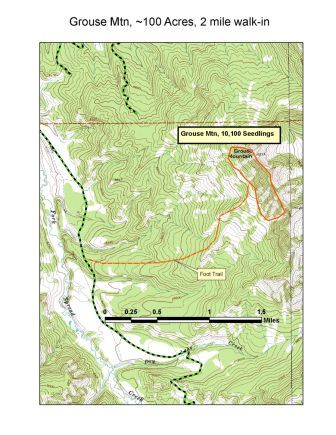2011 Sow WBP Seedlings for Grouse Mountain Restoration Project
Project: Sow Whitebark Pine Seedlings for Grouse Mtn Restoration Project
Agency/Forest or Park/District: Buffalo Ranger District, Bridger-Teton National Forest
Project coordinator: Karl Buermeyer
Contact
Karl Buermeyer, Zone Vegetation Manager USDA Forest Service, Bridger-Teton National Forest Blackrock Ranger Station, Moran, WY 83013 Phone: 307-543-3909 Fax: 307-543-9149 email: kbuermeyer@fs.fed.us
Cooperators
Rocky Mountain Research Station
Source of funding /amount
FHP: $13,200 and $6,800 US Forest Service Region 4
Supplemental funding: $4,814 from NFTM, SPS4 Coeur d’Alene Nursery.
Dates of restoration efforts
Sow order (Coeur d’Alene Nursery) fall 2011, planned outplanting fall 2013.
Objectives
Proposed treatments would 1) release younger whitebark pine (seedling to pole sized) to improve survival and promote cone-bearing qualities, 2) release mature whitebark pine from competition and reduce risk from fire, bark beetles and white pine blister rust, and 3) create openings in mixed stands to promote natural regeneration. Surviving whitebark pine seed trees will be inventoried and protected with verbenone using FHP MPB funds. Spotty natural regeneration in upper-elevation pure whitebark pine with high mortality would be supplemented by interplanting in the future. Monitoring by Rocky Mountain Research Station would assess the effectiveness of the treatments in achieving the project objectives.
Acres/ha treated
73 acres
Methods
Proposed treatments include release of whitebark pine to reduce competition and pressure  from bark beetles, fire and blister rust, and creating openings in mixed stands to promote natural regeneration. Bob Keane of the Rocky Mountain Research Station visited the area in September 2010, and felt that broadcast burning would have limited utility due to the risk of losing existing whitebark pine, but smaller areas would be burned following slashing in created openings to control competition from subalpine fir. Upper elevations would be interplanted with whitebark pine in the future to supplement existing natural regeneration. TSI funds will be requested to thin stands regenerated from clearcuts in the 1970’s to remove competition to vigorous whitebark pine saplings and increase resistance to mountain pine beetle infestation. Forest Health Protection Mountain Pine Beetle funds have been requested in 2011 to fully inventory the project area and locate, document and protect (Verbenone) surviving seed trees. Stand exams conducted in the summer of 2010 show low volumes of merchantable timber (30 – 180 sq ft/ac) especially considering the location (distance to mills) and accessibility of the area. Restoration funds are requested to cover expected deficits incurred in a stewardship contract to create openings. Should any of the requested funds not be needed to cover the expected deficit, the funds would be used to sow seedlings for the next phase of the project – interplanting heavily impacted pure whitebark pine stands on the higher slopes. The Rocky Mountain Research Station would install study plots and collect and analyze data to monitor the success of the treatments.
from bark beetles, fire and blister rust, and creating openings in mixed stands to promote natural regeneration. Bob Keane of the Rocky Mountain Research Station visited the area in September 2010, and felt that broadcast burning would have limited utility due to the risk of losing existing whitebark pine, but smaller areas would be burned following slashing in created openings to control competition from subalpine fir. Upper elevations would be interplanted with whitebark pine in the future to supplement existing natural regeneration. TSI funds will be requested to thin stands regenerated from clearcuts in the 1970’s to remove competition to vigorous whitebark pine saplings and increase resistance to mountain pine beetle infestation. Forest Health Protection Mountain Pine Beetle funds have been requested in 2011 to fully inventory the project area and locate, document and protect (Verbenone) surviving seed trees. Stand exams conducted in the summer of 2010 show low volumes of merchantable timber (30 – 180 sq ft/ac) especially considering the location (distance to mills) and accessibility of the area. Restoration funds are requested to cover expected deficits incurred in a stewardship contract to create openings. Should any of the requested funds not be needed to cover the expected deficit, the funds would be used to sow seedlings for the next phase of the project – interplanting heavily impacted pure whitebark pine stands on the higher slopes. The Rocky Mountain Research Station would install study plots and collect and analyze data to monitor the success of the treatments.
Planting? If so, source of seedlings? Resistance?
Seedlot was DEADLINE11, 10,000 feet elevation on the Kemmerer Ranger District of the BTNF. Seed lot is operational – phenotypically resistant, but not rust screened.
Outcome
Collected cones from appropriate seed elevation zone. Seeds were sown in spring 2012 as planned. Planting contract was awarded, however, early snow and Government shutdown prevented outplanting in fall 2013. Seedlings were returned to the nursery to be put back into storage and winter dormancy, will attempt to outplant again in fall 2014.
Monitoring since completion of the project
Dates Received seedlings from nursery on Sept 19, 2013, in good condition, however, not able to outplant.
Plans for future monitoring? Once planted, survival will be checked by stake rows after 1st and 3rd growing seasons, and walkthrough surveys periodically after that.
Will outcome meet goals? Yes, assuming successful outplanting and adequate survival
Future actions/follow up? Planting contract will be modified to extend to fall 2014.